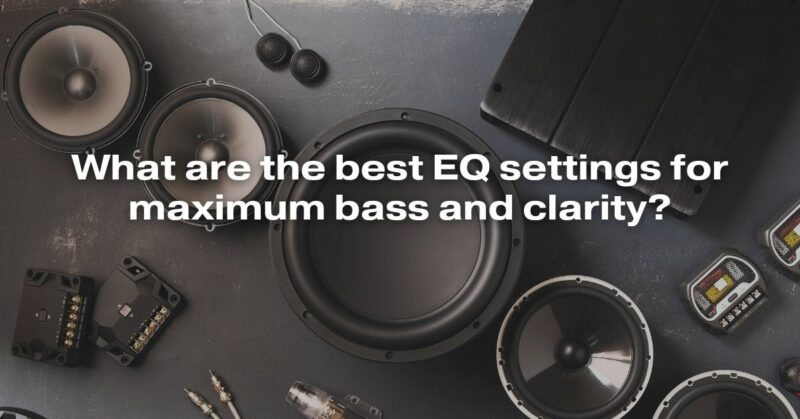Equalization, or EQ, is a powerful tool in the world of audio that allows you to adjust the balance of frequencies in your sound system. When it comes to achieving the perfect audio experience, finding the best EQ settings for maximum bass and clarity is essential. Whether you’re setting up a home theater, tuning your car audio, or fine-tuning your headphones, understanding how to optimize your EQ settings can make a significant difference in your listening pleasure.
In this comprehensive article, we’ll delve into the fundamentals of equalization, the science behind it, and practical tips to help you achieve the perfect balance of bass and clarity in your audio setup.
Understanding Equalization
Equalization, often referred to as EQ, is the process of adjusting the frequency response of an audio system to achieve a desired sound. It involves boosting or cutting specific frequency ranges to enhance or diminish certain aspects of the audio. EQ can be applied to various audio components, including speakers, amplifiers, headphones, and software-based audio players.
To understand EQ settings for bass and clarity, it’s crucial to grasp the basics of the frequency spectrum. The audible frequency range for humans typically spans from 20 Hz (bass) to 20,000 Hz (treble). Bass frequencies are generally lower in pitch, while treble frequencies are higher. A typical EQ graph displays these frequencies on a horizontal axis and the amplitude (volume) on a vertical axis.
The Science of Bass and Clarity
To achieve maximum bass and clarity, you need to consider how the human ear perceives different frequencies. The ear’s sensitivity to various frequency ranges varies, and understanding this can help you make informed EQ adjustments.
- Bass Frequencies: Our ears are more sensitive to midrange frequencies, which include many elements of speech and music. Boosting bass frequencies excessively can lead to a muffled or muddy sound. For maximum bass impact without sacrificing clarity, focus on the lower end of the bass spectrum, around 80-100 Hz.
- Midrange Frequencies: The midrange frequencies (around 1 kHz to 5 kHz) are essential for clarity and detail in audio. Too much or too little emphasis in this range can affect the intelligibility of vocals and instruments. Aim for a balanced response in this area.
- Treble Frequencies: Treble frequencies (above 5 kHz) add sparkle and definition to audio. Boosting the treble can enhance clarity, but excessive treble can lead to harshness and fatigue. Adjust the treble carefully to find the sweet spot between detail and comfort.
Practical Tips for Optimal EQ Settings
Now that you have a foundational understanding of EQ and the science behind bass and clarity, let’s explore practical tips for achieving the best EQ settings:
- Start with Flat EQ: Begin with a flat or neutral EQ setting. This provides a baseline to work from and ensures you’re not introducing unwanted coloration to the audio.
- Room Acoustics: Consider your room’s acoustics. The layout, furniture, and wall surfaces can significantly affect how sound travels. Addressing acoustic issues through room treatment may be necessary before fine-tuning EQ.
- Use Quality Equipment: High-quality speakers or headphones are essential for achieving the best audio experience. Invest in equipment that can reproduce a wide range of frequencies accurately.
- Experiment Gradually: Make EQ adjustments incrementally. Start by making small changes and listening carefully. This prevents overcorrection and allows you to fine-tune without compromising sound quality.
- Use Reference Tracks: Play well-recorded reference tracks that you’re familiar with. This will help you identify specific areas where your EQ adjustments are needed.
- Equalize for Content: Adjust your EQ settings based on the type of content you’re listening to. Music genres, movies, and games may benefit from different EQ profiles.
- Avoid Extreme Boosts: Avoid extreme boosts or cuts in any frequency range, especially in the bass and treble. These can lead to distortion, clipping, or discomfort.
- Save Your Settings: If your EQ system allows it, save your customized settings for different situations, such as music, movies, or gaming.
- Regularly Reevaluate: As your audio setup or listening environment changes, periodically revisit your EQ settings to ensure they remain optimized.
Conclusion
Finding the best EQ settings for maximum bass and clarity is both a science and an art. It involves understanding the fundamentals of equalization, considering the human ear’s sensitivity to different frequencies, and making precise adjustments based on your equipment and listening environment.
Remember that the perfect EQ settings can vary from person to person and depend on personal preferences. Trust your ears, experiment patiently, and strive for a balance that delivers both powerful bass and crystal-clear audio. With dedication and careful adjustment, you can unlock the full potential of your audio system and enjoy a rich and immersive listening experience.


